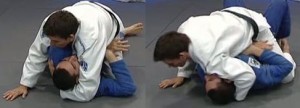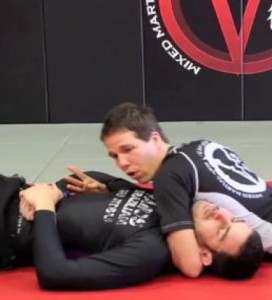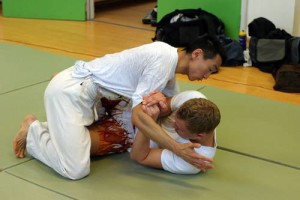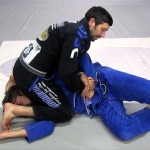I’ve been focusing a lot on pin escapes in BJJ class lately. Instead of normal rolling, I just allow someone to start pinning me and go live with escapes only. Tonight I did an hour straight of live pin escapes with no rest. I wrote down some notes for my own use and I thought I’d share them here. By ‘pin’, I refer to any form of side control, scarf hold, or north/south. These are considered some of the hardest positions to escape.
To be clear, this post is not about escaping. It’s only about not getting tapped and using minimal energy to do it.
Here are some simple principles for surviving under a pin. If you just do these, your pin submission defense will go way up. Escaping the pin requires more sophistication, but first things first.
- You want your head to be free to move. If your head or neck are misaligned, the highest priority is to realign them and free them.
- You want your head facing their hips most of the time.
- You don’t want your head facing straight up.
- Keep your arms between you and your opponent. If your arms are out of posture, get them in before proceeding.
- When possible, defend submissions by using small hip bumps, not by using your arms.
1) You want your head to be free to move. If your head or neck are misaligned, the highest priority is to realign them and free them.
If your head is being crossfaced to the left, there’s no way you can do any escapes to your right. If your head is being crossfaced to your right, there’s no way you can escape to your left. If your neck is being bent sideways so your ear moves towards your shoulder, you can’t do any escapes without risking hurting yourself. The first priority is to prevent your opponent from using their arms, legs, hips, etc. to twist or bend your neck.
2) You want your head facing their hips most of the time.
Everybody who does jiu-jitsu knows you’re supposed to turn to face the opponent and start hip escaping away, which is correct and ideal. Turning your whole body to face the opponent is not so easy against someone who has a crushing pin. But often turning your head is easier. Many of the higher percentage attacks from pins involve the top guy forcing your head to turn away from their hips. These would include the north/south arm bar, the north/south kimura, the paper cutter choke, the north/south guillotine, many variations of cross collar choke, etc.
So the opponent pinning you is going to want to crossface you to make your head look away.
With their forearm/bicep like this:

or using their torso or hips like this:

First, you can use one or both hands to try to prevent this as seen here:

But second, to turn your head with a crossface requires pushing hard against the side of your head to twist your head away. If you’re looking at their hips, then the front of your face is pointed towards their driving power. They can’t use their driving power against the side of your head to twist your head. So simply by looking at their hips, you’re making it much harder to crossface you. In the picture above, the guy on the bottom has good head positioning; even if he wasn’t using his hands to defend, the top guy would need to scoop under his head and push hard on the left side of his head, a direction in which he doesn’t have anywhere near as much power. If the bottom guy was looking straight up, the top guy could launch forward driving off his legs, and the left side of the bottom guy’s face would be wide open for cross-facing.
As they move their hips around, you are always changing the angle of your head to match them. For example, if they’re on their knees, their hips will be a little higher vertically, so your head angle can also be more upward. If they sprawl back away from you, their hips will be down on the ground so you can look more downward. If they change their angle so their hips are more down towards your legs, you can turn your head to look that way. If their hips start circling up towards north/south, you turn your head upward to face them. So when I say turn your head towards their hips, it means a very precise angle that is always moving, not just like “turn my head to the right”.
3) You don’t want your head facing straight up.
When your head is facing up, that means your strongest push is straight up against gravity, which is weak. If you combine this with rule number 1 (your head points towards their hips) it also means you really don’t want their hips to be vertically above your head in the north/south teabagging position.
Like this:

In that position your head has very little freedom of movement and they can use their hips or knees to turn your face away.
Here’s the trick to stop the opponent from getting that position:
Let’s say the opponent starts on side control with his legs on your right side. As he circles around to north south, turn your head to face his hips as he circles, and use your arms to push him up horizontally in the direction of your head and to the right as he circles. This is to redirect his hips away from your head. Your push is kind of with his momentum, so you don’t need much power. At the same time, walk your feet in a circle to the right, as though you’re trying to stay under side control. If you do it right, he’ll feel there is too much space and go back to side control, which is what we want.
If you mess up slightly, he’ll make it to north/south, but he won’t be able to get his hips directly above your head, he’ll be up horizontally in the direction of your head. Your head will have good freedom of movement and you can try to do an escape or just swing side to side until you’re back under side control.
4) Keep your arms between you and your opponent. If your arms are out of posture, get them in before proceeding.
The purpose of this is to make it harder to armlock you, and also so that you can push on your opponent when you need to. As a corollary, keep your elbows close to your ribs, because your opponent will try to separate your elbows from your body in order to get your arms out of posture.
5) When possible, defend submissions by using small hip bumps, not by using your arms.
By hip bump, I mean the upa/bridge/hip lift.
When you use your arms for defending subs, your defensive arm posture will be inevitably loosened. So it’s undesirable to use your arms if you don’t have to. Many times when the opponent goes for a submission while you have good posture, in order to break your posture, they will overcommit their weight in one direction or another. Just give them one or two small, short, low effort hip bumps in that direction and it will off balance them enough that they have to let go of the submission in order to base out with their arms. Since you’re bumping them in the direction their weight already is driving, it doesn’t take much power. If they’re driving hard across your body, this is a situation where you may need to briefly look away from their hips in order to bump in the direction their weight is driving. If you’re not sophisticated enough to feel which direction their weight is driving, you can sometimes get away with just picking one or two random directions.
These are general rules; certainly there are situations which are exceptions. But if you do these things, it really helps. The only times I got tapped in the hour of pin escapes were when the top guy managed to turn my head away.
For more on preserving freedom of movement for your head, a good set of videos to watch are Firas Zahabi’s
Fast and easy Side Control Escape
Fast and Easy Side-Control Escape 2